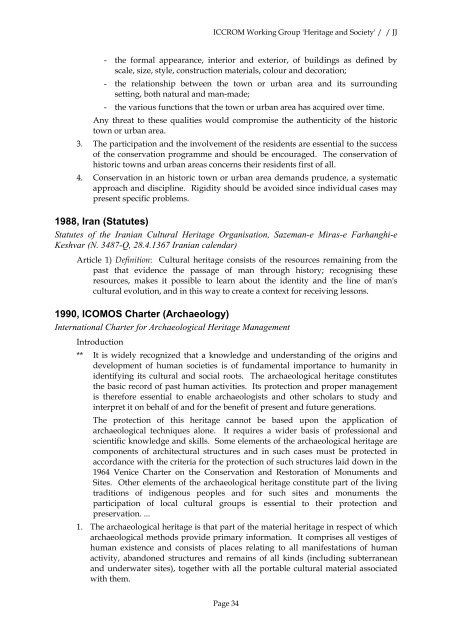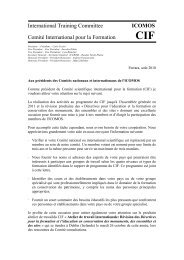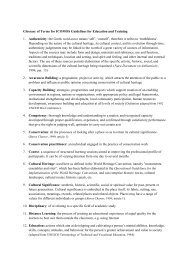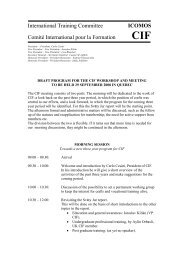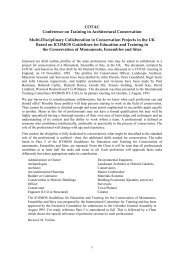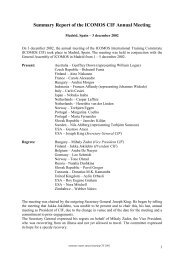Definition of Cultural Heritage -- References to ... - CIF - Icomos
Definition of Cultural Heritage -- References to ... - CIF - Icomos
Definition of Cultural Heritage -- References to ... - CIF - Icomos
You also want an ePaper? Increase the reach of your titles
YUMPU automatically turns print PDFs into web optimized ePapers that Google loves.
ICCROM Working Group '<strong>Heritage</strong> and Society' / / JJ<br />
- the formal appearance, interior and exterior, <strong>of</strong> buildings as defined by<br />
scale, size, style, construction materials, colour and decoration;<br />
- the relationship between the <strong>to</strong>wn or urban area and its surrounding<br />
setting, both natural and man-made;<br />
- the various functions that the <strong>to</strong>wn or urban area has acquired over time.<br />
Any threat <strong>to</strong> these qualities would compromise the authenticity <strong>of</strong> the his<strong>to</strong>ric<br />
<strong>to</strong>wn or urban area.<br />
3. The participation and the involvement <strong>of</strong> the residents are essential <strong>to</strong> the success<br />
<strong>of</strong> the conservation programme and should be encouraged. The conservation <strong>of</strong><br />
his<strong>to</strong>ric <strong>to</strong>wns and urban areas concerns their residents first <strong>of</strong> all.<br />
4. Conservation in an his<strong>to</strong>ric <strong>to</strong>wn or urban area demands prudence, a systematic<br />
approach and discipline. Rigidity should be avoided since individual cases may<br />
present specific problems.<br />
1988, Iran (Statutes)<br />
Statutes <strong>of</strong> the Iranian <strong>Cultural</strong> <strong>Heritage</strong> Organisation, Sazeman-e Miras-e Farhanghi-e<br />
Keshvar (N. 3487-Q, 28.4.1367 Iranian calendar)<br />
Article 1) <strong>Definition</strong>: <strong>Cultural</strong> heritage consists <strong>of</strong> the resources remaining from the<br />
past that evidence the passage <strong>of</strong> man through his<strong>to</strong>ry; recognising these<br />
resources, makes it possible <strong>to</strong> learn about the identity and the line <strong>of</strong> man's<br />
cultural evolution, and in this way <strong>to</strong> create a context for receiving lessons.<br />
1990, ICOMOS Charter (Archaeology)<br />
International Charter for Archaeological <strong>Heritage</strong> Management<br />
Introduction<br />
** It is widely recognized that a knowledge and understanding <strong>of</strong> the origins and<br />
development <strong>of</strong> human societies is <strong>of</strong> fundamental importance <strong>to</strong> humanity in<br />
identifying its cultural and social roots. The archaeological heritage constitutes<br />
the basic record <strong>of</strong> past human activities. Its protection and proper management<br />
is therefore essential <strong>to</strong> enable archaeologists and other scholars <strong>to</strong> study and<br />
interpret it on behalf <strong>of</strong> and for the benefit <strong>of</strong> present and future generations.<br />
The protection <strong>of</strong> this heritage cannot be based upon the application <strong>of</strong><br />
archaeological techniques alone. It requires a wider basis <strong>of</strong> pr<strong>of</strong>essional and<br />
scientific knowledge and skills. Some elements <strong>of</strong> the archaeological heritage are<br />
components <strong>of</strong> architectural structures and in such cases must be protected in<br />
accordance with the criteria for the protection <strong>of</strong> such structures laid down in the<br />
1964 Venice Charter on the Conservation and Res<strong>to</strong>ration <strong>of</strong> Monuments and<br />
Sites. Other elements <strong>of</strong> the archaeological heritage constitute part <strong>of</strong> the living<br />
traditions <strong>of</strong> indigenous peoples and for such sites and monuments the<br />
participation <strong>of</strong> local cultural groups is essential <strong>to</strong> their protection and<br />
preservation. ...<br />
1. The archaeological heritage is that part <strong>of</strong> the material heritage in respect <strong>of</strong> which<br />
archaeological methods provide primary information. It comprises all vestiges <strong>of</strong><br />
human existence and consists <strong>of</strong> places relating <strong>to</strong> all manifestations <strong>of</strong> human<br />
activity, abandoned structures and remains <strong>of</strong> all kinds (including subterranean<br />
and underwater sites), <strong>to</strong>gether with all the portable cultural material associated<br />
with them.<br />
Page 34


